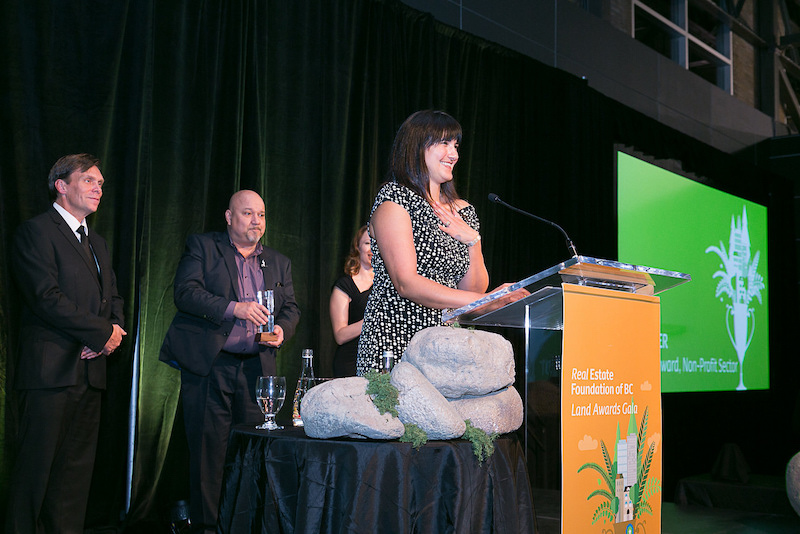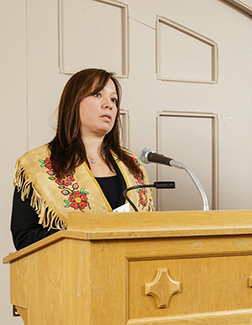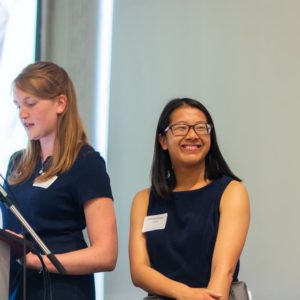2018 Winners and Finalists

Land Champion
Lana Lowe
 The Land Champion Award recognizes a leader who has made a significant impact on land use, conservation, and/or real estate practices in BC.
The Land Champion Award recognizes a leader who has made a significant impact on land use, conservation, and/or real estate practices in BC.
Lana Lowe, a Dene from Fort Nelson First Nation, has made enormous contributions to manage and protect water, land, and wildlife habitat in northeast British Columbia.
As Director of Lands at Fort Nelson First Nation (FNFN), Lana has led work to manage the impacts of oil and gas development in the Nation’s territory. Working with the community, Lana laid the groundwork for a framework for land and water management that is based in both Dene knowledge and values and scientific approaches to ecosystem management and responsible, informed land use in the territory.
In developing the framework, Lana established community-led research and water monitoring programs, collaborated with governments, industry, NGOs and academia, and created a community databank that is used in impacts assessment, regulatory and policy review, land use planning, and legal actions that have resulted in the prevention of over-extraction of water for fracking and the protection of threatened caribou in the territory.
Emerging Leader
Veronika Bylicki and Tesicca Truong
 The Emerging Leader Award recognizes the impact that a new leader is having on land use, conservation, or real estate in BC.
The Emerging Leader Award recognizes the impact that a new leader is having on land use, conservation, or real estate in BC.
Tessica Truong and Veronika Bylicki are the co-founders of CityHive, an organization that works to engage youth in civic affairs and sustainability.
In their work with CityHive, Veronika and Tessica have launched two pop-up “think-and-do” tanks, formed youth hubs on city-building, and advocated for youth inclusion in city planning. Together, the duo have tackled issues like housing affordability, public spaces, and civic engagement.
Projects: Land Use and Conservation
Finalists
Land use is the human use and management of land. This award category includes broad land and community planning projects, conservation and ecosystem protection, and restoration of land affected by resource development.
WINNER: Municipal Natural Assets Initiative
Smart Prosperity Institute, Brooke and Associates, David Suzuki Foundation, and the Town of Gibsons
Natural features and ecosystems (like marshes, forests, and shorelines) can deliver services (like stormwater absorption, water filtration, erosion control) to communities.
The Municipal Natural Assets Initiative helps communities to “count” these natural assets and assign a value that’s equivalent to the service a human-built asset would provide. By counting nature as an asset, municipalities can make a strong financial case for protection and conservation, while relying less on engineered assets.
BC First Nations Land Use Planning Handbook
Naut’sa mawt Tribal Council
For First Nations communities, land use planning is a way for community members to tell their Nation’s story, make decisions about land and resources, and assert their rights to self-governance. However, there are very few resources and community planning tools specifically for Indigenous people.
Naut’sa mawt Tribal Council worked with Beringia Community Planning and an advisory group of Indigenous planners to create a BC First Nations Land Use Planning Handbook. The Handbook walks communities through the steps needed to prepare for planning, make decisions, act on a plan, and reflect on outcomes.
Embracing Our Potential
Thompson Okanagan Tourism Association
Tourism is a major economic driver in the Thompson Okanagan Region, bringing in $2.2 billion a year. To ensure that tourism remains sustainable and that the benefits are shared, the Thompson Okanagan Tourism Association worked with municipalities and First Nations to develop a ten-year tourism strategy.
“Realizing Our Potential” uses GeoFence technology to coordinate marketing and influence the flow of tourists through the region. This connects visitors to the right experiences, at the right time, minimizing negative impacts. Last year, the region was the first in the Americas to be identified as a Biosphere Certified Destination.
Projects: Built Environment
Finalists
The built environment includes all of the physical buildings and infrastructure of a community, as well as the planning, development, and real estate practices that integrate them. This award category includes community planning, as well as housing, transportation, buildings, and infrastructure.
WINNER: BC Energy Step Code
Energy Step Code Council
The Province of British Columbia has committed to ensuring that all new buildings will be net-zero energy-ready by 2032. To help the province reach this target, a group of industry and local government experts worked to develop the BC Energy Step Code.
The BC Energy Step Code is all about energy performance. The Code sets energy-efficiency targets, and challenges designers and builders to determine the best ways to meet them. To date, 15 local governments have adopted the BC Energy Step Code, and 16 more are considering doing so.
Olivia Skye
Atira Development Society
Safe, affordable housing is the foundation communities are built on.
Olivia Skye, located in Vancouver’s downtown eastside, includes 198 homes for women-led households. The building’s mix of studio and on-bedroom homes are rented at rates that are affordable at a range of incomes.
Olivia Skye is built to LEED Gold standards and includes amenities like a community space, a gym, and a suite for out-of-town guests.
BC’s Affordable Housing Plan
BC Non-Profit Housing Association
With support from the BC Rental Housing Coalition, the BC Non-Profit Association created a ten-year plan to significantly reduce affordable housing challenges in communities across the province. The Affordable Housing plan draws on existing data and makes specific, costed recommendations.
Since sharing the plan, the Province of BC has committed $1.9 billion to funding the provincial component of the plan. At the federal level, the National Housing Strategy includes large investments in housing and income supports.
Nuutsumuut Lelum
Nanaimo Aboriginal Centre
With nearly half of Nanaimo renters spending more than the can afford on housing costs, there is a huge need for more affordable rental housing, especially for Indigenous families.
The Nanaimo Aboriginal Centre’s Nuutsummut Lelum community includes 25 new homes for community members, at rents families can afford. The townhomes are built to Passive House design standards, requiring very little energy to heat and cool. The community also features Métis art, a 37-foot Coast Salish totem pole, and spaces for cultural and family gatherings.
Projects: Fresh Water and Food Systems
Finalists
Land use and real estate practices have a significant impact on BC’s fresh water and food systems. This award category recognizes projects that help communities protect freshwater ecosystems (rivers, lakes, streams), manage and conserve water, or build local and sustainable food systems.
WINNER: POLIS Water Sustainability Project
POLIS Project on Ecological Governance at the University of Victoria
BC’s fresh water is our most precious natural resource. Laws and policies, when implemented and enforced, can be powerful tools for protecting our rivers, streams, lakes, and wetlands.
The POLIS Water Sustainability Project, based out of the University of Victoria, works to drive innovation in water law, policy, and governance. The POLIS team has led research influencing BC’s Water Sustainability Act. Today, they work with researchers, local governments, First Nations, and funders to make policy recommendations, support watershed governance, and build capacity for community water protection.
Young Agrarians Land Matching Program
FarmFolk CityFolk
For new farmers, BC’s high farmland prices present a barrier to entry. For farmers reaching retirement age, leasing their land can provide income while supporting them to age in place.
The Young Agrarians Land Matching Program pairs new farmers looking for land to lease with landowners who want their land farmed. A Land Matcher support the process by tracking inquiries, making matches, drawing up legal land agreements, and providing information about regulations and resources. To date, Young Agrarians has heard from 500 interested farmers and landowners.
Southwest BC Food System Design Project
Institute for Sustainable Food Systems at Kwantlen Polytechnic University
The Southwest BC bioregion (which surrounds Metro Vancouver) includes 101,000 hectares of food-producing land and can hypothetically grow enough to meet 40% of local food need.
To better understand the region’s food production potential, the KPU Institute for Sustainable Food Systems team created a model to explore the potential for a local food and its impacts on food self-reliance, the economy, and environmental stewardship. The model includes four future scenarios for 2050: baseline, increased food self-reliance, minimum environmental impact, and maximum land in production.
Join Our Newsletter
Subscribe and stay up to date!
Follow Us
Join the conversation: #LandAwards
